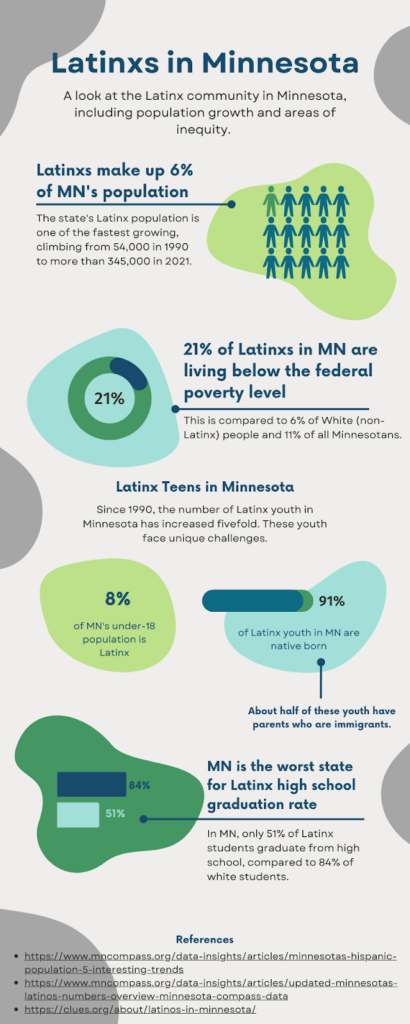Some Latinx youth and teens face significant challenges, such as:
- Immigration trauma and documentation concerns.
- Family separation and reconnection stress.
- Poverty and racism.
Latinx immigrant trauma and documentation concerns
Many Latinx teens living in the country were not born in the United States. Many may not have entered the country in a legal way. They may not have had a say in their family’s decision to immigrate. There are many reasons why Latinx families choose to immigrate illegally to the United States. While each Latinx teen immigrant’s story is different, many of their stories include violence, loss, forced family separation and other trauma.
Because Latinx families often leave their homes and communities without time to prepare, they may not have the documentation they need to enter the U.S. legally. This means that they will not have legal permission to live, work and drive in this country. Those who have not been “legalized” also lack access to community resources, travel and other rights and privileges of U.S. citizens. Individuals found living and/or working in the U.S. without the proper documentation may be arrested, incarcerated and even deported.
Latinx family separation and reconnection stress
Many Latinx youth and teens have experienced family separation and trauma due to immigration, community violence and more. These youth may be living with family and friends in the U.S. They may barely know the people they live with. Latinx youth may face challenges adjusting to their new family and community. This can lead to behavioral, emotional or physical problems.
Not all families and children are able to reunite. However, even if and when families and children are able to reunite, the process of coming back together can lead to more trauma, conflict and challenges. For example, children who were separated from their parents as toddlers may have grown up speaking a different language and living in a different culture. Having difficulty communicating and dealing with cultural differences can cause problems when reconnecting as a family. This can also make it hard for these Latinx youth to reconnect with their communities and cultural heritage.
Poverty and Racism
Latinx youth and families experience poverty at higher rates than White (non-Latinx) people. Many factors increase the risk of poverty for a Latinx family. Language, documentation and an education gap can be barriers to accessing community resources and jobs. Traumas that impact mental health and family patterns can also increase the chance a Latinx teen lives in poverty.
Check out these resources to learn more about Latinx youth and adults in Minnesota:
- Comunidades Latinas Unidas En Servicio (CLUES): Latinos in Minnesota
- MN Compass: Minnesota’s Hispanic Population
Ways to Support & Be a Resource for Latinx Youth
School systems, teachers and school employees can support Latinx students by:
Learn a greeting, basic questions or phrases in the student’s native language. Since deportation is such a feared reality in the Latinx immigrant community, students might hesitate to talk about deeper family issues, especially if there are documentation concerns in the family. However, a Latinx student might be more comfortable talking about their family if they trust you. Making an effort to learn their native language is one way to help you earn their trust.
Sometimes the lens we look at others through impacts how we interact with them. Be aware of your opinions, biases and assumptions about the Latinx community. Even if a student behaves in a certain way, try not to judge them or their behavior based on your past experience, misinformation and stereotypes.
Get to know the student, their culture and story. Listening to someone can create a sense of belonging. You might be surprised at the deeper connections and common experiences you share with the student.
You might also consider facilitating reflective activities with them, such as the Letter to Younger Self or the Box of Courage. These might help teens to reflect on their experiences and share them with you as they feel comfortable.
Mental Health First Aid is an evidence-based approach to support youth by providing adults with knowledge and skills on:
- Common signs and symptoms of mental health challenges many youth experience, including anxiety, depression, and eating disorders.
- Common signs and symptoms of substance use challenges.
- How to interact with youth in crisis and connect them with help.
The training is available for anyone in the community. Click here for more information and to register for a course.
Let Latinx immigrant students know that being undocumented is not a mandated reportable offense. When concerns come up, this fact might help a student share their stories or problems. Become familiar with local resources and the requirements to access those resources. It can be frustrating and discouraging to be offered support only to find out you don’t meet the guidelines to receive that support.
Latinx youth want what every young person wants: to be seen, to be recognized as important, and to be valued. School staff often spend the most time with teens. You may observe changes that concern you. School staff can make even the quietest newcomer feel seen and valued. This can significantly impact the well-being of all students.


 Pinterest
Pinterest  Instagram
Instagram 

